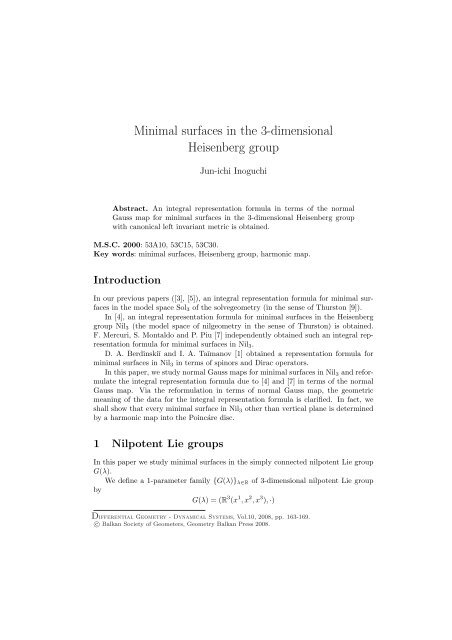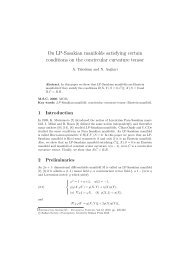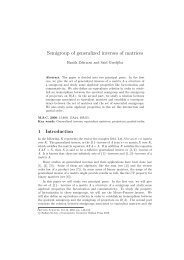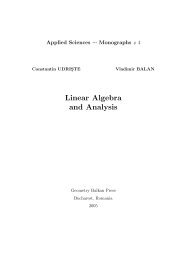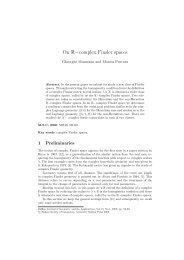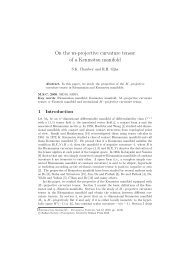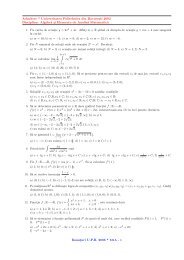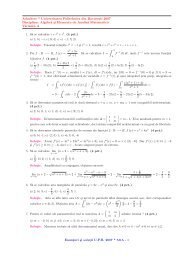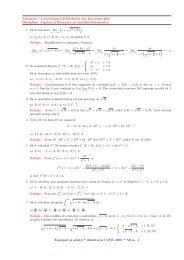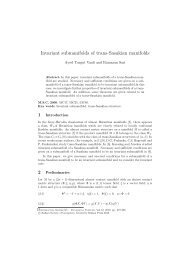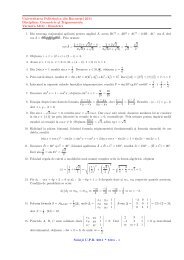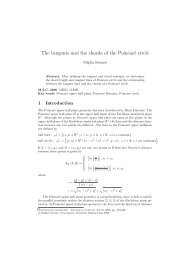Minimal surfaces in the 3-dimensional Heisenberg group
Minimal surfaces in the 3-dimensional Heisenberg group
Minimal surfaces in the 3-dimensional Heisenberg group
Create successful ePaper yourself
Turn your PDF publications into a flip-book with our unique Google optimized e-Paper software.
<strong>M<strong>in</strong>imal</strong> <strong>surfaces</strong> <strong>in</strong> <strong>the</strong> 3-<strong>dimensional</strong><strong>Heisenberg</strong> <strong>group</strong>Jun-ichi InoguchiAbstract. An <strong>in</strong>tegral representation formula <strong>in</strong> terms of <strong>the</strong> normalGauss map for m<strong>in</strong>imal <strong>surfaces</strong> <strong>in</strong> <strong>the</strong> 3-<strong>dimensional</strong> <strong>Heisenberg</strong> <strong>group</strong>with canonical left <strong>in</strong>variant metric is obta<strong>in</strong>ed.M.S.C. 2000: 53A10, 53C15, 53C30.Key words: m<strong>in</strong>imal <strong>surfaces</strong>, <strong>Heisenberg</strong> <strong>group</strong>, harmonic map.IntroductionIn our previous papers ([3], [5]), an <strong>in</strong>tegral representation formula for m<strong>in</strong>imal <strong>surfaces</strong><strong>in</strong> <strong>the</strong> model space Sol 3 of <strong>the</strong> solvegeometry (<strong>in</strong> <strong>the</strong> sense of Thurston [9]).In [4], an <strong>in</strong>tegral representation formula for m<strong>in</strong>imal <strong>surfaces</strong> <strong>in</strong> <strong>the</strong> <strong>Heisenberg</strong><strong>group</strong> Nil 3 (<strong>the</strong> model space of nilgeometry <strong>in</strong> <strong>the</strong> sense of Thurston) is obta<strong>in</strong>ed.F. Mercuri, S. Montaldo and P. Piu [7] <strong>in</strong>dependently obta<strong>in</strong>ed such an <strong>in</strong>tegral representationformula for m<strong>in</strong>imal <strong>surfaces</strong> <strong>in</strong> Nil 3 .D. A. Berd<strong>in</strong>skiĭ and I. A. Taĭmanov [1] obta<strong>in</strong>ed a representation formula form<strong>in</strong>imal <strong>surfaces</strong> <strong>in</strong> Nil 3 <strong>in</strong> terms of sp<strong>in</strong>ors and Dirac operators.In this paper, we study normal Gauss maps for m<strong>in</strong>imal <strong>surfaces</strong> <strong>in</strong> Nil 3 and reformulate<strong>the</strong> <strong>in</strong>tegral representation formula due to [4] and [7] <strong>in</strong> terms of <strong>the</strong> normalGauss map. Via <strong>the</strong> reformulation <strong>in</strong> terms of normal Gauss map, <strong>the</strong> geometricmean<strong>in</strong>g of <strong>the</strong> data for <strong>the</strong> <strong>in</strong>tegral representation formula is clarified. In fact, weshall show that every m<strong>in</strong>imal surface <strong>in</strong> Nil 3 o<strong>the</strong>r than vertical plane is determ<strong>in</strong>edby a harmonic map <strong>in</strong>to <strong>the</strong> Po<strong>in</strong>cáre disc.1 Nilpotent Lie <strong>group</strong>sIn this paper we study m<strong>in</strong>imal <strong>surfaces</strong> <strong>in</strong> <strong>the</strong> simply connected nilpotent Lie <strong>group</strong>G(λ).We def<strong>in</strong>e a 1-parameter family {G(λ)} λ∈R of 3-<strong>dimensional</strong> nilpotent Lie <strong>group</strong>byG(λ) = (R 3 (x 1 , x 2 , x 3 ), ·)Differential Geometry - Dynamical Systems, Vol.10, 2008, pp. 163-169.c○ Balkan Society of Geometers, Geometry Balkan Press 2008.
164 Jun-ichi Inoguchiwith multiplication:(x 1 , x 2 , x 3 ) · (˜x 1 , ˜x 2 , ˜x 3 ) = (x 1 + ˜x 1 , x 2 + ˜x 2 , x 3 + ˜x 3 + λ 2 (x1˜x 2 − ˜x 1 x 2 ) ).The unit element of G(λ) is ⃗0 = (0, 0, 0). The <strong>in</strong>verse element of (x 1 , x 2 , x 3 ) is−(x 1 , x 2 , x 3 ). Obviously, G(0) is <strong>the</strong> abelian <strong>group</strong> (R 3 , +).The Lie algebra g(λ) of G(λ) is R 3 with commutation relations:(1) [E 1 , E 2 ] = λ E 3 , [E 2 , E 3 ] = [E 3 , E 1 ] = ⃗0with respect to <strong>the</strong> natural basis E 1 = (1, 0, 0), E 2 = (0, 1, 0), E 3 = (0, 0, 1). Theformulae (1) imply that g(λ) is nilpotent. The left translated vector fields of E 1 , E 2 ,E 3 aree 1 = ∂∂x − λy ∂2 ∂z , e 2 = ∂ ∂y + λx ∂2 ∂z , e 3 = ∂ ∂z ,respectively.We equip an <strong>in</strong>ner product 〈·, ·〉 on g(λ) so that {E 1 , E 2 , E 3 } is orthonormal withrespect to it. Then <strong>the</strong> result<strong>in</strong>g left <strong>in</strong>variant Riemannian metric g = g λ on G(λ) is(2) g λ = (dx 1 ) 2 + (dx 2 ) 2 + ω ⊗ ω,where(3) ω = dx 3 + λ 2 (x2 dx 1 − x 1 dx 2 ).The one-form ω satisfies dω ∧ ω = −λdx 1 ∧ dx 2 ∧ dx 3 . Thus ω is a contact form onG(λ) if and only if λ ≠ 0.The homogeneous Riemannian 3-manifold (G(λ), g λ ) is called <strong>the</strong> 3-<strong>dimensional</strong><strong>Heisenberg</strong> <strong>group</strong> if λ ≠ 0. Note that (G(0), g 0 ) is <strong>the</strong> Euclidean 3-space. Thehomogeneous Riemannian 3-manifold (G(1), g 1 ) is frequently referred as <strong>the</strong> modelspace Nil 3 of <strong>the</strong> nilgeometry <strong>in</strong> <strong>the</strong> sense of Thurston [9].2 Matrix <strong>group</strong> model of G(λ)The Lie <strong>group</strong> G(λ) is realised as a closed sub<strong>group</strong> of <strong>the</strong> general l<strong>in</strong>ear <strong>group</strong> GL 4 R.In fact, G(λ) is imbedded <strong>in</strong> GL 4 R by ι : G(λ) → GL 4 R;⎛⎞e x1 0 0 0ι(x 1 , x 2 , x 3 ) = ⎜ 0 1 λx 1 x 3 + λ 2⎝x1 x 2⎟0 0 1 x 2 ⎠ .0 0 0 1Clearly ι is an <strong>in</strong>jective Lie <strong>group</strong> homomorphism. Thus G(λ) is identified with⎧⎛⎞⎫e ⎪⎨x1 0 0 0⎜ 0 1 λx 1 x 3 + λ 2⎝x1 x 2⎪⎬⎟0 0 1 x ⎪⎩2 ⎠ ∣ x1 , x 2 , x 3 ∈ R .⎪⎭0 0 0 1
<strong>M<strong>in</strong>imal</strong> <strong>surfaces</strong> <strong>in</strong> <strong>the</strong> 3-<strong>dimensional</strong> <strong>Heisenberg</strong> <strong>group</strong> 165The Lie algebra g(λ) corresponds to⎧⎛⎪⎨⎜⎝⎪⎩u 1 0 0 00 0 λu 1 u 30 0 1 u 20 0 0 0The orthonormal basis {E 1 , E 2 , E 3 } is identified withE 1 =⎛⎜⎝1 0 0 00 0 λ 00 0 0 00 0 0 0⎞⎟⎠ , E 2 =⎛⎜⎝⎞⎫⎪⎬⎟⎠ ∣ u1 , u 2 , u 3 ∈ R .⎪⎭1 0 0 00 0 0 00 0 0 10 0 0 0The Levi-Civita connection ∇ if g is given by⎞⎟⎠ , E 3 =⎛⎜⎝1 0 0 00 0 0 10 0 0 00 0 0 0⎞⎟⎠ .∇ E1 E 1 = 0, ∇ E1 E 2 = λ 2 E 3, ∇ E1 E 3 = − λ 2 E 2,(1) ∇ E2 E 1 = − λ 2 E 3, ∇ E2 E 2 = 0, ∇ E2 E 3 = λ 2 E 1,∇ E3 E 1 = − λ 2 E 2, ∇ E3 E 2 = λ 2 E 1, ∇ E3 E 3 = 0.The Riemannian curvature tensor R def<strong>in</strong>ed by R(X, Y ) = [∇ X , ∇ Y ]−∇ [X,Y ] is givenby(2) R 1 212 = − 3λ24 , R1 313 = R 2 323 = λ24 .The Ricci tensor field Ric is given by(3) R 11 = R 22 = − λ22 , R 33 = λ22 .The scalar curvature ρ of G is ρ = −λ 2 /2. The natural-reducibility obstruction Udef<strong>in</strong>ed by2g(U(X, Y ), Z) = g(X, [Z, Y ]) + g(Y, [Z, X]),X, Y, Z ∈ g(λ)is given by(4) U(E 1 , E 3 ) = − λ 2 E 3, U(E 2 , E 3 ) = λ 2 E 1.Note that U measures <strong>the</strong> non right-<strong>in</strong>variance of <strong>the</strong> metric. In fact U = 0 if andonly if g is right <strong>in</strong>variant (and hence bi<strong>in</strong>variant). The formulae (4) implies that g isbi<strong>in</strong>variant if and only if λ = 0.The follow<strong>in</strong>g formula was obta<strong>in</strong>ed <strong>in</strong> [4] (see also [7, (9)]).
166 Jun-ichi InoguchiProposition 2.1 ([4]-II) Let {ω 1 , ω 2 , ω 3 } be a solution to(5)(6)(7)¯∂ω 1 =λ2 (ω2 ∧ ω 3 − ω 2 ∧ ω 3 );¯∂ω 2 = − λ 2 (ω1 ∧ ω 3 − ω 1 ∧ ω 3 );¯∂ω 3 = − λ 2 (ω1 ∧ ω 2 + ω 1 ∧ ω 2 )on a simply connected coord<strong>in</strong>ate region D ⊂ C. Then∫ z(ϕ(z, ¯z) = 2 Re ω 1 , ω 2 , ω 3 − λ )z 02 (x2 · ω 1 − x 1 · ω 2 )is a harmonic map <strong>in</strong>to Nil 3 . Moreover if <strong>in</strong> addition, {ω 1 , ω 2 , ω 3 } satisfiesandω 1 ⊗ ω 1 + ω 2 ⊗ ω 2 + ω 3 ⊗ ω 3 = 0,ω 1 ⊗ ω 1 + ω 2 ⊗ ω 2 + ω 3 ⊗ ω 3 ≠ 0.Then ϕ is an m<strong>in</strong>imal immersion.Conversely, any harmonic map of D <strong>in</strong>to Nil 3 can be represented <strong>in</strong> this form.3 The normal Gauss mapLet ϕ : M → G(λ) be a conformal immersion. Take a unit normal vector field Nalong ϕ. Then, by <strong>the</strong> left translation we obta<strong>in</strong> <strong>the</strong> follow<strong>in</strong>g smooth map:ψ := ϕ −1 · N : M → S 2 ⊂ g(λ).The result<strong>in</strong>g map ψ takes value <strong>in</strong> <strong>the</strong> unit sphere <strong>in</strong> <strong>the</strong> Lie algebra g(λ). Here,via <strong>the</strong> orthonormal basis {E 1 , E 2 , E 3 }, we identify g(λ) with Euclidean 3-spaceE 3 (u 1 , u 2 , u 3 ).The smooth map ψ is called <strong>the</strong> normal Gauss map of ϕ ([6], [3, p. 370]).Express <strong>the</strong> data as ω i = φ i dz. First we consider <strong>the</strong> case “φ 3 ≡ 0”. In this case,we have(x 1 z) 2 + (x 2 z) 2 = 0, |x 1 z| 2 + |x 2 z| 2 > 0,x 3 z + λ 2 (x1 zx 2 − x 1 zx 2 ) = 0.These equation imply that <strong>the</strong> m<strong>in</strong>imal surface determ<strong>in</strong>ed by <strong>the</strong> condition φ 3 ≡ 0is an <strong>in</strong>tegral surface of <strong>the</strong> distribution ω = 0. The distribution ω = 0 is <strong>in</strong>tegrableif and only if λ = 0. When λ = 0, <strong>the</strong>n <strong>the</strong> surface is a vertical plane x 3 = constant.Hereafter we assume that φ 3 ≢ 0 and <strong>in</strong>troduce <strong>the</strong> mapp<strong>in</strong>g f and g by(1) f := φ 1 − √ −1φ 2 , g :=φ 3φ 1 − √ −1φ 2 .By def<strong>in</strong>ition, f and g take values <strong>in</strong> <strong>the</strong> extended complex plane C = C∪{∞}. Us<strong>in</strong>g<strong>the</strong>se functions f and g, we obta<strong>in</strong> <strong>the</strong> follow<strong>in</strong>g formula.
<strong>M<strong>in</strong>imal</strong> <strong>surfaces</strong> <strong>in</strong> <strong>the</strong> 3-<strong>dimensional</strong> <strong>Heisenberg</strong> <strong>group</strong> 167Theorem 3.1 Let f and g be solutions to <strong>the</strong> system:√ √ −1λ−1λ(2) f¯z = − |f| 2 ḡ(1 − |g| 2 ), g¯z = − ¯f(1 − |g| 2 ) 224over a simply connected coord<strong>in</strong>ate region D ⊂ C. Then <strong>the</strong> mapp<strong>in</strong>g(3) ϕ(z, ¯z) = ( ϕ 1 (z, ¯z), ϕ 2 (z, ¯z), ϕ 3 (z, ¯z) ) : D → G(λ),def<strong>in</strong>ed by∫ z( 1ϕ 1 (z, ¯z) = 2 Re))z 02 f(1 − g2 dz,∫ z(√ )−1(4) ϕ 2 (z, ¯z) = 2 Rez 02 f(1 + g2 ) dz,∫ z[ {ϕ 3 (z, ¯z) = 2 Re f g + λ (√−1ϕ 1 (1 + g 2 ) − ϕ 2 (1 − g 2 ) )}] dz.z 04is a weakly conformal harmonic map <strong>in</strong>to G(λ).Conversely, every weakly conformal harmonic map ϕ : D → G(λ) (o<strong>the</strong>r thanvertical plane when λ = 0) is represented <strong>in</strong> this form.Proof. By <strong>the</strong> assumption φ 3 ≢ 0. Hence <strong>the</strong> harmonicity toge<strong>the</strong>r with <strong>in</strong>tegrability(5)–(7) for ϕ areφ 1¯z + λ 2 (φ2 φ 3 + φ 2 φ 3 ) = 0,φ 2¯z − λ 2 (φ1 φ 3 + φ 1 φ 3 ) = 0,φ 3¯z − λ 2 (φ1 φ 2 − φ 1 φ 2 ) = 0.This system is equivalent to√ √ −1λ−1λf¯z = − |f| 2 ḡ(1 − |g| 2 ), g¯z = ¯f(1 − |g| 2 ) 2 .24Thus we obta<strong>in</strong> <strong>the</strong> required result. ✷Remark 3.1 In [7], Mercuri, Montaldo and Piu <strong>in</strong>troduced <strong>the</strong> follow<strong>in</strong>g auxiliaryfunctions:for Nil 3 = G(1). Then we haveG 2 = f 2 , H = g · Gφ 1 = G 2 − H 2 , φ 2 = √ −1(G 2 + H 2 ), φ 3 = 2GH.These functions are solutions to <strong>the</strong> system:2 √ −1G¯z = (|G| 2 − |H| 2 )H, 2 √ −1H¯z = (|G| 2 − |H| 2 )G.
168 Jun-ichi InoguchiThe <strong>in</strong>tegral representation formula is rewritten as ([7, Theorem 4.3])∫ zϕ 1 (z, ¯z) = 2 Re ( G 2 − H 2) dz,z 0ϕ 2 (z, ¯z) = 2ϕ 3 (z, ¯z) = 2∫ zRe {√ −1 ( G 2 + H 2)} dz,z 0[Re 2GH + 1 {ϕ 2 (G 2 − H 2 ) − √ −1ϕ 1 (G 2 + H 2 ) }] dz. □z 02∫ zThe normal Gauss map of (3-4) is computed as(5) ψ(z, ¯z) =11 + |g| 2 (2Re (g)E1 + 2Im (g)E 2 + (|g| 2 − 1)E 3).Under <strong>the</strong> stereographic projection π : S 2 \ {∞} ⊂ g(λ) → C := RE 1 + RE 2 ,<strong>the</strong> map ψ is identified with <strong>the</strong> C-valued function g. Based on this fundamentalobservation, we may call <strong>the</strong> function g <strong>the</strong> normal Gauss map of ϕ.When λ ≠ 0, from (2), we can deduce <strong>the</strong> follow<strong>in</strong>g partial differential equationfor g:(6) (1 − |g| 2 )g z¯z + 2ḡg z g¯z = 0.If |g| = 1, <strong>the</strong>n (6) implies that g is constant. In such a case, ψ has <strong>the</strong> formψ = cos θE 1 + s<strong>in</strong> θE 2 , g = cos θ + √ −1 s<strong>in</strong> θ.Thus <strong>the</strong> correspond<strong>in</strong>g m<strong>in</strong>imal surface is a vertical plane, i.e., a plane parallel to<strong>the</strong> x 3 -axis ([4, II, Example 1.11], [8, p. 91]).From (5), one can see that <strong>the</strong> third component of ψ is positive if and only if|g| 2 < 1.The equation (6) means that if g satisfies |g| 2 < 1, <strong>the</strong>n g is a harmonic map <strong>in</strong>to<strong>the</strong> unit disc D <strong>in</strong> C = RE 1 + RE 2 ;D = {w = uE 1 + √ −1vE 2 |u, v ∈ R}equipped with <strong>the</strong> Po<strong>in</strong>caré metric 4dwd ¯w/(1 − |w| 2 ).Corollary 3.1 Let D be a simply connected region <strong>in</strong> C and g : D → D be a harmonicmap <strong>in</strong>to <strong>the</strong> unit disc. Let f be a function def<strong>in</strong>ed by f = −4 √ −1λḡ z /(1 − |g| 2 ) 2 .Then <strong>the</strong> mapp<strong>in</strong>g ϕ def<strong>in</strong>ed by (3)-(4) is a weakly conformal harmonic map <strong>in</strong>to <strong>the</strong><strong>Heisenberg</strong> <strong>group</strong> G(λ) (λ ≠ 0).Acknowledgement The author was partially supported by Kakenhi 16740029,18540068.
<strong>M<strong>in</strong>imal</strong> <strong>surfaces</strong> <strong>in</strong> <strong>the</strong> 3-<strong>dimensional</strong> <strong>Heisenberg</strong> <strong>group</strong> 169References[1] D. A. Berd<strong>in</strong>skiĭ and I. A. Taĭmanov, Surfaces <strong>in</strong> three-<strong>dimensional</strong> Lie <strong>group</strong>s(Russian), Sibirsk. Mat. Zh. 46 (2005), no. 6, 1248–1264. English Translation:Siberian Math. J. 46 (2005), no. 6, 1005–1019.[2] J. Inoguchi, <strong>M<strong>in</strong>imal</strong> <strong>surfaces</strong> <strong>in</strong> 3-<strong>dimensional</strong> solvable Lie <strong>group</strong>s, Ch<strong>in</strong>ese Ann.Math. B. 24 (2003), 73–84.[3] J. Inoguchi, <strong>M<strong>in</strong>imal</strong> <strong>surfaces</strong> <strong>in</strong> 3-<strong>dimensional</strong> solvable Lie <strong>group</strong>s II, Bull. Austral.Math. Soc. 73 (2006), 365–374.[4] J. Inoguchi, T. Kumamoto, N. Ohsugi and Y. Suyama, Differential geometry ofcurves and <strong>surfaces</strong> <strong>in</strong> 3-<strong>dimensional</strong> homogeneous spaces I–IV, Fukuoka Univ.Sci. Rep. 29 (1999), 155–182, 30 (2000), 17–47, 131–160, 161–168.[5] J. Inoguchi and S. Lee, A Weierstrass repesenttaion for m<strong>in</strong>imal <strong>surfaces</strong> <strong>in</strong> Sol,Proc. Amer. Math. Soc., 136 (2008), 2209–2216.[6] M. Kokubu, Weierstrass representation for m<strong>in</strong>imal <strong>surfaces</strong> <strong>in</strong> hyperbolic space,Tôhoku Math. J. 49 (1997), 367–377.[7] F. Mercuri, S. Montaldo and P. Piu, A Weierstrass representation formula form<strong>in</strong>imal <strong>surfaces</strong> <strong>in</strong> H 3 and H 2 × R, Acta Math. S<strong>in</strong>. Engl. Ser. 22 (2006), no. 6,1603–1612[8] A. San<strong>in</strong>i, Gauss map of a surface of <strong>the</strong> <strong>Heisenberg</strong> <strong>group</strong>, Boll. Un. Mat. Ital.B (7), 11-B suppl. facs. 2 (1997), 79–93.[9] W. M. Thurston, Three-<strong>dimensional</strong> Geometry and Topology I, Pr<strong>in</strong>ceton Math.Series. 35 (Pr<strong>in</strong>ceton University Press, Pr<strong>in</strong>ceton N. J., 1997).Author’s address:Jun-ichi InoguchiDepartment of Ma<strong>the</strong>matics Education,Faculty of Education, Utsunomiya University,Utsunomiya, 321-8505, Japan.E-mail: <strong>in</strong>oguchi@cc.ustunomiya-u.ac.jp


